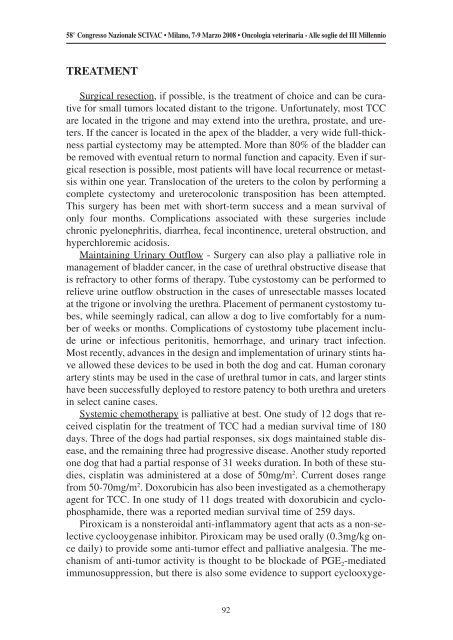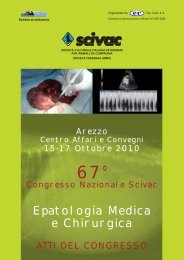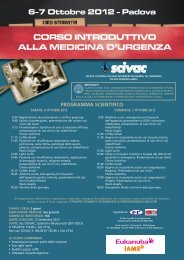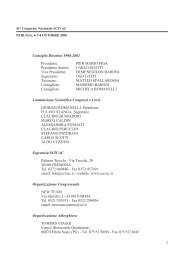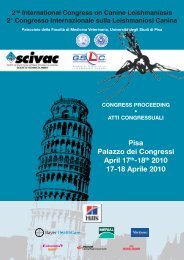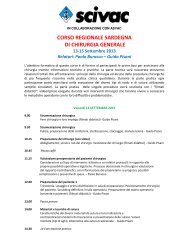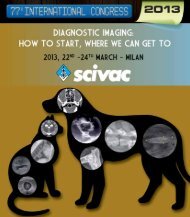58° Congresso Nazionale SCIVAC: Oncologia veterinaria
58° Congresso Nazionale SCIVAC: Oncologia veterinaria
58° Congresso Nazionale SCIVAC: Oncologia veterinaria
You also want an ePaper? Increase the reach of your titles
YUMPU automatically turns print PDFs into web optimized ePapers that Google loves.
58° <strong>Congresso</strong> <strong>Nazionale</strong> <strong>SCIVAC</strong> • Milano, 7-9 Marzo 2008 • <strong>Oncologia</strong> <strong>veterinaria</strong> - Alle soglie del III Millennio<br />
TREATMENT<br />
Surgical resection, if possible, is the treatment of choice and can be curative<br />
for small tumors located distant to the trigone. Unfortunately, most TCC<br />
are located in the trigone and may extend into the urethra, prostate, and ureters.<br />
If the cancer is located in the apex of the bladder, a very wide full-thickness<br />
partial cystectomy may be attempted. More than 80% of the bladder can<br />
be removed with eventual return to normal function and capacity. Even if surgical<br />
resection is possible, most patients will have local recurrence or metastsis<br />
within one year. Translocation of the ureters to the colon by performing a<br />
complete cystectomy and ureterocolonic transposition has been attempted.<br />
This surgery has been met with short-term success and a mean survival of<br />
only four months. Complications associated with these surgeries include<br />
chronic pyelonephritis, diarrhea, fecal incontinence, ureteral obstruction, and<br />
hyperchloremic acidosis.<br />
Maintaining Urinary Outflow - Surgery can also play a palliative role in<br />
management of bladder cancer, in the case of urethral obstructive disease that<br />
is refractory to other forms of therapy. Tube cystostomy can be performed to<br />
relieve urine outflow obstruction in the cases of unresectable masses located<br />
at the trigone or involving the urethra. Placement of permanent cystostomy tubes,<br />
while seemingly radical, can allow a dog to live comfortably for a number<br />
of weeks or months. Complications of cystostomy tube placement include<br />
urine or infectious peritonitis, hemorrhage, and urinary tract infection.<br />
Most recently, advances in the design and implementation of urinary stints have<br />
allowed these devices to be used in both the dog and cat. Human coronary<br />
artery stints may be used in the case of urethral tumor in cats, and larger stints<br />
have been successfully deployed to restore patency to both urethra and ureters<br />
in select canine cases.<br />
Systemic chemotherapy is palliative at best. One study of 12 dogs that received<br />
cisplatin for the treatment of TCC had a median survival time of 180<br />
days. Three of the dogs had partial responses, six dogs maintained stable disease,<br />
and the remaining three had progressive disease. Another study reported<br />
one dog that had a partial response of 31 weeks duration. In both of these studies,<br />
cisplatin was administered at a dose of 50mg/m 2 . Current doses range<br />
from 50-70mg/m 2 . Doxorubicin has also been investigated as a chemotherapy<br />
agent for TCC. In one study of 11 dogs treated with doxorubicin and cyclophosphamide,<br />
there was a reported median survival time of 259 days.<br />
Piroxicam is a nonsteroidal anti-inflammatory agent that acts as a non-selective<br />
cyclooygenase inhibitor. Piroxicam may be used orally (0.3mg/kg once<br />
daily) to provide some anti-tumor effect and palliative analgesia. The mechanism<br />
of anti-tumor activity is thought to be blockade of PGE 2 -mediated<br />
immunosuppression, but there is also some evidence to support cyclooxyge-<br />
92


